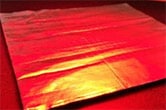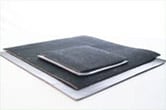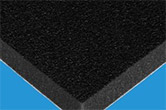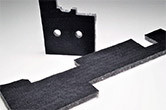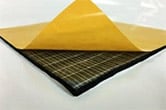Air compressor noise is a serious nuisance that can radiate from equipment all the way through a facility. When left uncontrolled, this problem impacts the marketability and customer value perception of your product. Fortunately, mitigating diffuse air compressor sound is possible using a combination of Technicon Acoustic products that that block sound, absorb sound, and reduce vibration.
Technicon offers a line of acoustic solutions for OEMs designing a variety of air compressor equipment, including:
- Centrifugal air compressors
- Reciprocal air compressors
- Oil-free and oil-injected air compressors
- Natural gas air compressors
- Rotary screw air compressors
Acoustic Baffling
Technicon Acoustics can also assist with already designed and existing power generator and air compressor enclosures with noise problems. We can create a compressed fiber acoustic baffle that will redirect the line of sight and airflow for the noise, making it difficult for it to escape. This is a perfect after-the-fact fix customized to your needs!
Hotspots
There are many hotspots found within an enclosure which need to be accounted for to protect sensitive components, electronics, computer equipment, and engine parts. In addition to the internal protection, hotspots also touch outside the unit. Our Tech Shield™ can be installed anywhere in an enclosure to ensure surface temperatures are reduced as well.
Walls
- Acoustic Solutions
Walls of an enclosure can be lined with acoustic absorber foam or our PF-091 fiber. These materials are used to prevent sound waves from reflecting off hard surfaces and traveling out of it. As a result, these enclosures are much more effective in reducing noise. An enclosure without proper acoustical treatments could be counter-intuitive!
- Vibration Damping
In addition to the acoustic solutions, we also are able to add vibration damping to the composite for an all-in-one solution. This reduces both noise and vibration resonance coming from the equipment.
Doors
- Acoustic Solutions
Doors of an enclosure for power generators and air compressors take up significant surface area. This makes it important to treat it with acoustic material, such as our acoustic absorber foam or PF-091 fiber.
- Thermal Solutions
UL standards require a power generator or an air compressor enclosure to stay below a threshold of surface temperature. This can only be done with proper thermal treatments. We have the expertise to help you comply with these regulations while reducing unwanted noise simultaneously.
Acoustic material placed on the door can often be parallel to a hot exhaust pipe. In this case, we recommend reducing the composite’s material thickness to make room for our Tech Shield™ product within to help block heat. With Technicon, you don’t have to compromise your acoustic solutions for thermal ones – they can coexist!
For more detail to these specific solutions, check out the below infographic and click each section for more information!
Types of Air Compressor Noise to Reduce
Although air compressor noise might sound simple to identify, it can actually arise from several different sources. The best solution for a noisy air compressor often depends on why the system is so loud, and whether the problematic noise is structure-borne or airborne.
Structure-Borne Noise
Structure-borne noise arises from vibration within the air compressor itself. Air compressor housings contain many metal components that, when improperly balanced, can resonate as they vibrate against one another. The best time to address structure-borne noise is during the manufacturing process—if the compressor is built properly, the components are aligned such that only minimal vibration can transfer throughout the system. Whatever vibration persists can then be controlled using vibration damping materials.
- Solution: Vibration damping materials, which reduce noise propagation by lowering the amount of vibration transmitted from one element to another.
- Technicon product suggestion: Vibration Damping Materials
Technicon damping materials can help to prevent structure-borne noise before it occurs. However, if an existing system is acting up, strategic placement of vibration-damping pads might be the best solution.
Airborne Noise
Like structure-borne noise, airborne noise is best addressed during the design process. The difference is that airborne noise arises as air enters or exits the compressor. A quality compressor design should ensure that all entry and exit paths for airflow are tortuously designed. Incorporating turns into air paths eliminates line-of-sight noise transmission, which is a common cause of airborne noise. It is also critical that designers ensure that every surface of an air compressor housing is properly treated, as neglecting even 10% of the surface area can reduce acoustical treatment effectiveness by half.
- Solution: Acoustic barriers and acoustic absorbers
- Technicon Product Suggestion: Barrier Composite (VBFF, VBF, VBP or VBPF series) Absorber Materials (AF or PF series)
The key to solving an existing airborne noise problem is to isolate the noisy system as much as possible. Sound tends to take the easiest path possible as it travels, so obstructing its path from the compressor is key to reducing transmission. Acoustic barriers such as mass loaded vinyl (MLV) are designed block sound waves from leaving the compressor housing and penetrating throughout the facility. Acoustic absorbers, which are made of porous foam or fibers, can then be used on sound-reflective surfaces to absorb any remaining sound waves, preventing them from resonating inside the compressor housing and increasing the sound pressure levels of the equipment.
Airborne noise is tricky since it can escape through virtually any opening in the equipment. The key is to enclose the compressor with effective barriers and absorbers, ensuring that any sound waves produced are hampered on their way out.
Industries in Need of Quiet Air Compressors
Air compressors are found across many diverse industries and often operate in noisy environments. As such, it’s important to minimize noise generation as much as possible to prevent harm to employees and patrons. Industries that can especially benefit from quiet air compressors include:
- Construction. Air compressors power jackhammers, air sanders, impact wrenches, grinders, and similar tools. Since workers are already exposed to a variety of worksite noise hazards, these compressors should be kept as quiet as possible to minimize their contribution to overall noise pollution.
- Energy and utility. Energy companies often prefer pneumatic equipment since it tends to be lighter and safer than electrical alternatives. Damping noise on these tools helps protect essential workers as they install and repair electrical infrastructure.
- Manufacturing. Air compressors might be used for any number of sprays, ventilation, presses, and other pneumatic machines in an industrial facility. Manufacturers in agriculture, food and beverage, oil and gas, and similar industries are especially reliant on air compressors. Given that industrial plants contain many of these machines, in combination with other loud equipment, silencing air compressors is crucial to avoid compounding noise levels.
- Automotive. As with the other facilities described, automotive shops are already relatively loud, making it important to ensure that all equipment is well-designed for employee protection and noise damping. This includes pneumatic-powered painting, sanding, and cleaning equipment commonly used in detail work, pneumatic power tools, and larger pieces of equipment such as lifts.
Types of Air Compressors to Target for Noise Reduction
Air compressors come in a diverse range of shapes and sizes. Regardless of configuration, all air compressors can benefit from proper noise-reduction measures. Most types of air compressors are available in stationary and portable models.
Stationary compressors are found in industrial environments, including pneumatic lines used in food processing and water treatment plants. Permanent, stationary compressors are also used in hospitals to power surgical equipment and supply oxygen. Noise reduction in these cases is critical for employees and patients, especially since there are usually other sources of noise pollution working alongside the compressors.
Conversely, portable air compressors are used to power tools in the field. These are most commonly found at construction and repair sites. Using portable compressors introduces the added complication of bystanders, especially near populated construction sites. As such, noise reduction becomes even more critical to protect passersby who lack hearing protection.
Importance of Sound Reduction in Air Compressors
Prolonged noise exposure is not just irritating—it can be harmful, causing hearing damage and other complications. Since air compressors are ubiquitous in industry but also common noise producers, sound reduction measures are critical for safety.
Technicon Acoustics specializes in vibration-damping, sound-absorbing, and sound-blocking materials that protect against this common danger. Our facing materials are both effective and durable, and we offer customizations to suit a variety of practical and aesthetic considerations.
To learn more about how to reduce air compressor noise, contact our team, or request a quote today.
